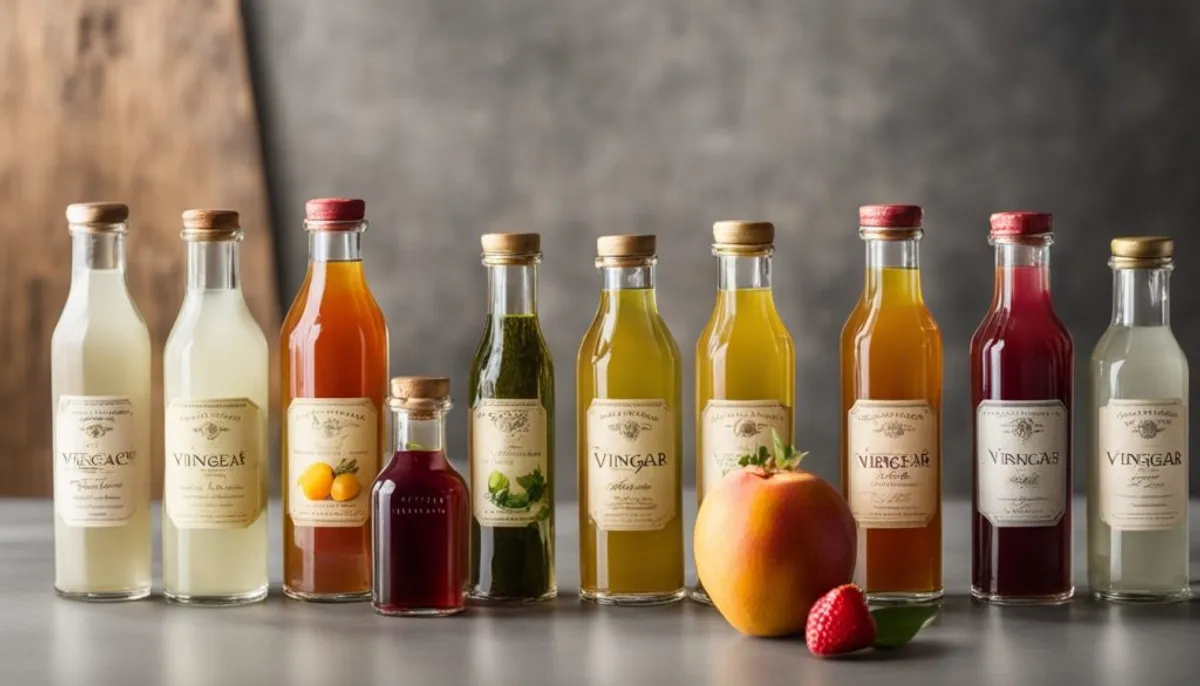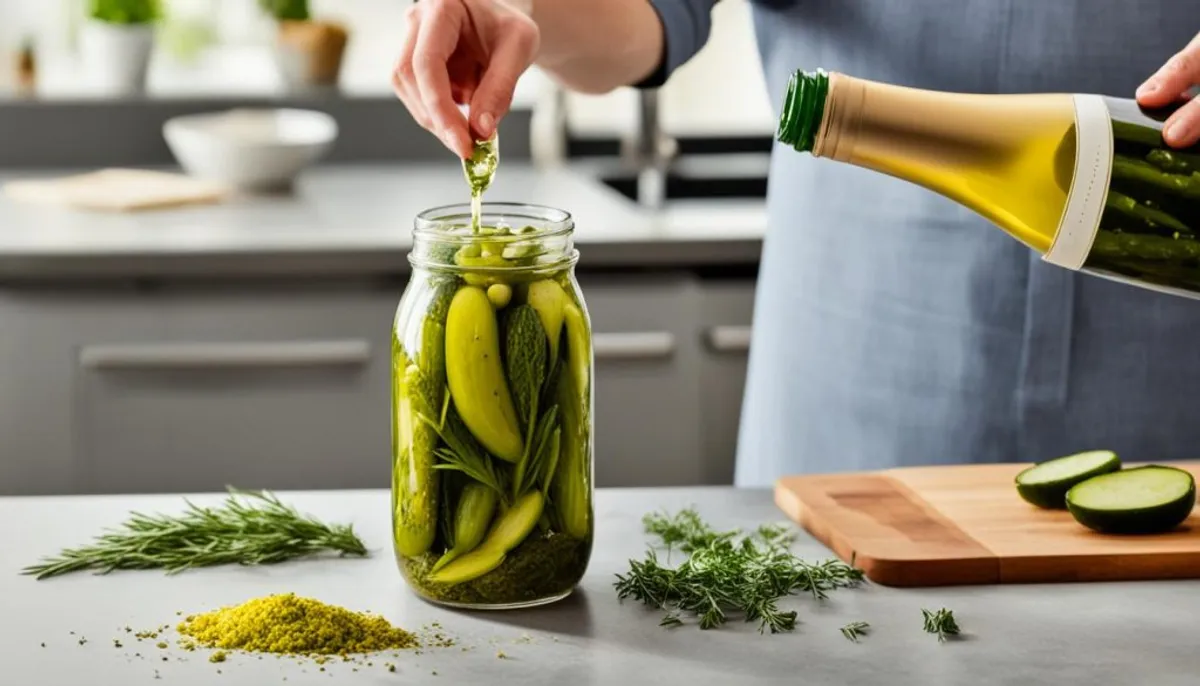Pickles have become a must-have in my fridge, and I’m not just talking about dill pickles. I’ve pickled all sorts of things, from red onions to fennel and even peaches. You can pickle almost anything. They’re not just for the side. Pickles add a pop of flavor that’s perfect before a meal or with any dish. I love their zesty taste. I know a lot about pickling, having learned in culinary school and pickled a lot at work.
I’m excited to share some pickling tips, tricks, and best practices with you. It’s a quick and simple way to enjoy yummy pickles any time.
Key Takeaways
- Pickles made with champagne vinegar have a mild, fruity flavor profile that complements a wide variety of produce.
- Champagne vinegar is a versatile choice for pickling vegetables and fruits.
- Adding aromatic herbs, spices, and other fresh ingredients can greatly enhance the flavor of homemade pickles.
- The quick pickling method involves a simple brine that can be prepared in just 10 minutes.
- Homemade pickles made with champagne vinegar are a must-have condiment that can elevate burgers, salads, and charcuterie boards.
The Benefits of Pickling
Pickles make fresh produce last longer. This method dates back to ancient Mesopotamia. By brining fruits or vegetables in vinegar, they stay fresh longer. This helps us use seasonal items fully and reduces food waste.
Extending Shelf Life of Fresh Produce
Pickles brighten up meals with their tangy flavor. They make simple dishes more exciting. You can eat pickled items alone, or put them in various meals like salads and sandwiches.
Adding Flavor and Variety to Meals
Pickling keeps the good stuff in fruits and veggies. Using vinegar, salt, and sugar in brine locks in their nutrients. It’s a great way to keep what’s healthy in our food.
Preserving Nutrients in Vegetables and Fruits
Eating pickles can be good for you. They help with digestion, blood sugar, and support a healthy gut. Even quick pickles have these health pluses.
What Can Be Pickled?
Many vegetables are great for pickling. They should be tasty and crunchy when raw. Think of carrots, fennel, and cucumbers. You can also pickle kohlrabi, green beans, and more.
Vegetables Suitable for Pickling
Some fruits with a firm texture pickle nicely too. Consider apples, pears, and stone fruits like peaches. Pineapples and certain berries work well. Softer fruits can be pickled but they need less time in the brine.
Fruits That Work Well for Pickling
You can pickle a vast range of vegetables and fruits. This leads to endless options for pickling. From crisp carrots to juicy peaches, the choice is yours. Sweet and sour cherries are great options too.
Understanding Pickling Ratios
The Classic Pickling Ratio
The classic ratio for pickling is simple and easy to remember. It includes 100% vinegar, 50% water, 25% sugar, and 12.5% kosher salt, all by weight. For instance, if you have 200g of vinegar, you’d have 100g water, 50g sugar, and 25g salt. Remember, use kosher salt because it’s not as salty by volume as table salt. It’s vital to weigh your ingredients. This is because 1 cup of water doesn’t weigh the same as 1 cup of sugar. If you were to measure by volume, your ratio would be off.
Importance of Using a Kitchen Scale
A kitchen scale is a must when you’re pickling with the classic recipe. Measuring by volume can throw off your brine’s balance. It’s because the weights of water, sugar, and salt aren’t the same. This way, you’ll get the right balance of flavors in your pickles by using a scale.
| Ingredient | Ratio | Example Weights |
|---|---|---|
| Vinegar | 100% | 200g |
| Water | 50% | 100g |
| Sugar | 25% | 50g |
| Kosher Salt | 12.5% | 25g |
Choosing the Right Vinegar
Champagne vinegar is perfect for pickling. It has a mild, fruity taste. This taste brings out the best in the produce. Unlike white vinegar, champagne adds a nuanced flavor. It works great with many vegetables and fruits, including when planting champagne ranunculus, which can also benefit from a pickled touch.
Champagne Vinegar: A Flavorful Choice
Champagne vinegar is known for its mild, fruity taste. This makes it perfect for using champagne vinegar to pickle. It complements veggies and fruits well. The mildness lets the natural produce flavors stand out in pickled items.
Other Vinegar Options for Pickling
White wine and rice vinegar are also good for pickling. They are not as sharp as white vinegar. Apple cider and red wine vinegar can be used too. The key is finding the right vinegar for the fruit or veggie’s flavor.

can you pickle with champagne vinegar
Champagne Vinegar’s Mild, Fruity Flavor
Champagne vinegar offers a mild and slightly fruity flavor. This makes it a standout for pickling. It doesn’t overpower the tastes of vegetables and fruits. The champagne vinegar keeps the natural flavors intact in the pickled items.
Versatility in Pickling Various Produce
With its mild and fruity flavor, champagne vinegar is great for pickling different fruits and veggies, especially when you take advantage of champagne specials. It works with both gentle and strong tastes. So, you can use it for things like soft peaches or crunchy cauliflower. It enhances their sweet and crispy qualities with a lovely hint of vinegar.
Adding Aromatics to Pickles
By adding things like peppercorns, cumin seeds, and bay leaves, the taste of pickles gets so much better. There’s also ginger, garlic, and fresh herbs. These extras bring a depth of flavor and let you personalize your pickles.
Herbs and Spices for Flavor Depth
There are so many ways to mix flavors in pickles. You can add unique herbs and spices depending on what you’re pickling. For instance, pickled jalapeños might taste great with cilantro and lime. Or, pickled onions could be spicy with ginger. Pickled carrots, on the other hand, may be wonderful with dill and coriander. Mixing different flavors lets you create your own tasty pickles.
Customizing Flavor Combinations
When making pickles, you have a lot of room to play with flavors. Think about what you’re pickling and the taste you want. You could try pickled jalapeños with cilantro, lime zest, and cumin. Or pickled onions with a kick from ginger and red pepper. For something different, pickled carrots with dill and coriander. Mixing flavors makes your pickles unique and tasty.

Quick Pickling Method
The quick pickling method is easy. You make a brine by mixing vinegar, water, sugar, and salt in a pan. Then you simmer it until everything dissolves. Next, you let it cool a bit before pouring it on your vegetables or fruits.
This warm mix softens the vegetables and fruits, making them pickle faster.
Preparing the Brine
The key brine mix is 100% vinegar, 50% water, 25% sugar, and 12.5% kosher salt. For a recipe, weigh out amounts like 200g vinegar and 100g water. It’s best to use a scale for accuracy. This mix makes sure your pickles taste just right.
Packing and Brining the Produce
Ready to pickle? Pack your vegetables or fruits in a clean, glass jar. Then pour the warm brine over them, covering everything. After cooling, seal the jar and put it in the fridge.
Let it pickle for at least 2 hours, but overnight is best. This way, they get that perfect pickle flavor.
Pickling Tips and Tricks
For tougher or larger cut blanching vegetables for pickling, like thick carrot spears or cauliflower florets, boil them briefly in salted water. This step softens them, making sure the whole veggie pickles evenly. If the pieces are too big, they might not pickle through before the smaller bits.
Avoiding Metallic Flavors
Use cookware and containers that don’t react with the pickling fluids to keep them tasting good. Vinegar and metal don’t mix well, as they can create a bad flavor in your pickles. Stick to stainless steel, ceramic, or glass. Avoid using cast iron, aluminum, or unlined copper for pickling.
Using Your Homemade Pickles
Homemade pickles are great on burgers and sandwiches. They add a tangy crunch that makes all the other flavors pop. The acidity in them cuts through the cheese or meat’s richness, creating a perfect bite.
Topping for Burgers and Sandwiches
If you’ve made pickles from cucumbers, onions, or even peaches, they’re a game changer. They make your burgers and sandwiches stand out. The [using pickles on burgers and sandwiches] adds a wonderful zing. And they balance the flavors perfectly, making the meal even tastier.
Adding Flavor to Salads and Charcuterie Boards
Pickled veggies and fruits do wonders for salads and charcuterie boards. They bring a salty, tangy kick and great texture. It’s a lovely contrast. They work well chopped on salads, grain bowls [using pickles in salads]. Plus, they’re essential for any fancy [adding pickles to charcuterie boards].
Conclusion
Pickling with champagne vinegar is a great way to keep your favorite fruits and veggies fresh. This vinegar’s soft, fruity taste works well with many plants. You can easily make great pickles by adding the right herbs and spices.
Those pickles are perfect for burgers, salads, or charcuterie. They add a delicious touch to any meal and make your food exciting. With champagne vinegar, you can keep the taste of what you pickle intact. Additionally, you can find the best bubbly offers to enhance your dining experience.
Champagne vinegar lets the natural flavors stand out. It’s a gentle vinegar, meaning it’s not too strong or overpowering. This makes it perfect for making your pickles taste amazing.
In the end, using champagne vinegar for pickling is simple and joyful. It keeps your produce for longer and adds a zesty kick to everything. It’s a great choice for anyone wanting to start pickling. Learn the right balance, and enjoy making your own tasty pickles.
FAQ
What makes champagne vinegar a good choice for pickling?
Champagne vinegar is mild and fruity. It won’t hide the taste of your pickled fruits and veggies. It adds perfect light acidity to pickles.
Can I substitute champagne vinegar for other types of vinegar when pickling?
Yes, champagne vinegar is a fine sub for white wine, rice, or apple cider vinegar in pickling. Just choose the vinegar strength based on what you’re pickling.
What types of fruits and vegetables work well for pickling with champagne vinegar?
It goes with many flavors, from gentle peaches to firm cauliflower. So, pick what you like because champagne vinegar can do it all.
How do I prepare the brine for pickling with champagne vinegar?
For the brine, mix 100% vinegar, 50% water, 25% sugar, and 12.5% kosher salt. Use a kitchen scale to get the right balance.
Can I add herbs, spices, and other aromatics to my champagne vinegar pickles?
Yes, add spices and herbs for more flavor. Try peppercorns, coriander, garlic, ginger, and citrus peels to mix things up.
How long do homemade champagne vinegar pickles last?
If you store them right, they can last from weeks to months in the fridge. How long depends on what you used and how you pickled.
Can I use the quick pickling method with champagne vinegar?
Quick pickling with champagne vinegar is a yes. Make a warm brine, pour over veggies or fruits, then fridge for at least 2 hours, but better for a full day.
What are some ways I can use my homemade champagne vinegar pickles?
Enjoy them as a snack or in meals. They go well in burgers, sandwiches, salads, and charcuterie to add a zesty, crispy touch.
RelatedRelated articles



